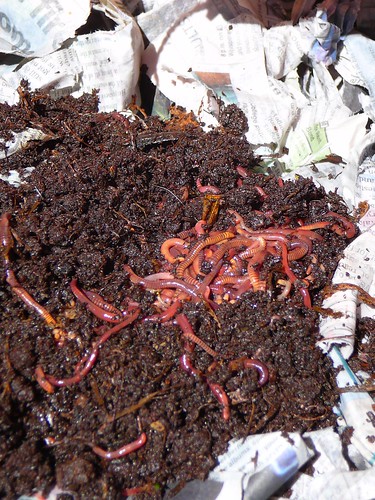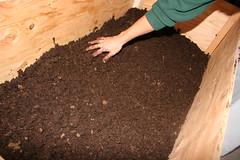by Wonder Worman | Sep 16, 2008 | Red Wiggler World
Keep an eye on moisture levels
I like to keep a layer of moist sheets of newspaper on top of my worm bins and check it regularly on hot summer days – even now in these late summer early fall days when the temperature can hover around the upper 80’s in the afternoon.
The sheets help keep the bedding moist and allow for the worms to make their way to the top layer to consume the scraps. Doing this, also helps with fruit flies. They seem to be contained under the sheets and not flying all around the bin. Fruit flies are more of a nuisance to humans than to the worms.
If you find the bedding to be too dry, sprinkle the bedding with some water. Remember the bedding should be similar to a wet sponge. You should be able to squeeze a little liquid out of it.
For more detailed information, check out “Wonder Worman’s Quick Guide to Red Wiggling”. It’s a quick guide to get you going and you can download it here.
by Wonder Worman | Jul 23, 2008 | Red Wiggler World
Is it time for you to change your bedding? Has the bedding turned a rich dark color? It may be time.
Since the Red Wigglers are in a contained environment and aren’t able to migrate to a different area, an area where their bedding isn’t overwhelmed by their waste, it’s important to provide that area for them. First expose the bin to light and your Red Wigglers will migrate to the bottom. Skim the top layer, this is the rich organic fertilizer that you have been waiting for! Save it or put it to use.
For more detailed information, check out “Wonder Worman’s Quick Guide to Red Wiggling”. It’s a quick guide to get you going and you can download it here.
by Wonder Worman | Jun 14, 2008 | Red Wiggler World
As with any new project, there may be a time when you are faced with a problem. Vermicomposting is no exception. Whether your worm bin bedding is too dry, too stinky, too big or too small, don’t let these things deter you. Because with every problem there is a solution. And remember, those little Red Wigglers are working for you!
Moisture levels.

When Red Wigglers are at their best, they produce lots of moisture. Their efforts along with the natural process of decomposition increases the moisture level in your worm bin. However, too much moisture can lead to disaster.
If the worms are in a plastic bin, the additional moisture will collect on the walls and lid of the bin. This is not a big problem, but if you notice liquid pooling in the worm’s bedding and the worms are bloated, white and look as though they are trying to escape there is definitely too much moisture and not enough drainage – it’s time to create more holes in the bottom of the bin. This solution will help immediately.
After the excess moisture has been drained, the bedding will still be very moist and adding dry shredded paper to your bin is a good next step. The paper can be newspaper or office paper. Doing this, will soak up the moisture within the bedding. Keep a close watch on the moisture level for the next few days and continue to feed the worms.
by Wonder Worman | Feb 2, 2008 | Red Wiggler World
Here’s an example of peat moss as a bedding for your red wigglers.




